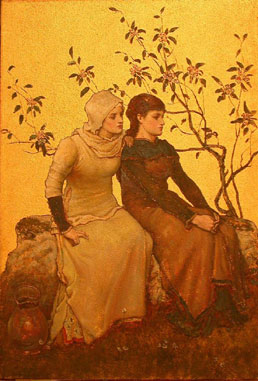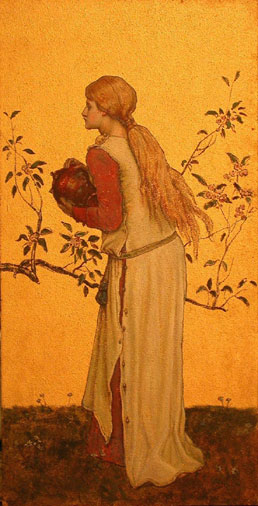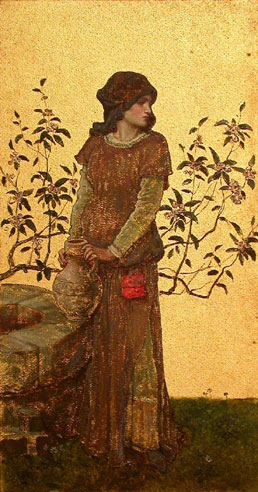Frederick Weekes (1833-1920)
Pre- Raphaelite Triptych
Oil on panel (3) All three Monogrammed F.W
Frederick Weekes was the son of distinguished sculptor Henry Weekes RA (1807-1877) and grew up in an artistic, antiquarian environment that nurtured a desire to train as a painter as well as an abiding and passionate interest in the history, artefacts and decoration of the Middle Ages. Weekes became a painter and an acknowledged expert on medieval costume and design, teaching at the Architectural Museum and exhibiting at the Royal Academy in the 1860’s.
It was probably through Weekes’ interest in medieval costume that he met and became associated with the leading Victorian ‘Gothic’ architect and designer, William Burges (1827-1881). The pair are known to have collected armour together (and eventually fell out acrimoniously on the subject – Weekes accusing Burges, whom he described as his ‘pupil’ of being ‘perfectly ignorant’.)
In happier times, Weekes worked very closely with Burges on a number of important projects, including Lord Bute’s Cardiff Castle and the architect’s own house, The Tower House in Holland Park, where he painted furniture and friezes. A number of painters were commissioned by Burges for such purposes but Weekes was arguably the most frequently used and knowledgeable of the architect’s clique. Weekes’ individuality and talent seems to have caused a certain amount of friction. Prof Joe Mordaunt Crook, in his book ‘William Burges and the High Victorian Dream’ states that because of his talent, Weekes “chafed unhappily as Burges’ satellite”.
Our triptych of paintings represents an exciting discovery in Weekes’ emerging oeuvre and have been dated by the leading authority in the field to the 1870s. Painted on stippled gold ground on high quality mahogany panel, the depictions of four pre-Raphaelite maidens around a well in Spring almost certainly formed part of an elaborate decorative scheme. They had languished unrecognised in a private house for most of the last century.
One possible candidate for the triptych’s original location was one of the most remarkable houses of the Victorian period: Milner Field, the home of Sir Titus Salt, the wool baron and philanthropist, who created the eponymous Saltaire, a model village for the workers in his mills. Salt’s own house, built in 1873, was an extraordinary, Wagnerian-scale mansion, constructed with every imaginable modern luxury but decorated throughout in ‘thirteenth century style’. Weekes designed a large number of decorative murals, paintings and stained glass panels for the house, some of which were removed by Salt’s widow when she left the house in 1903.
|




